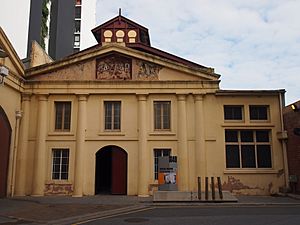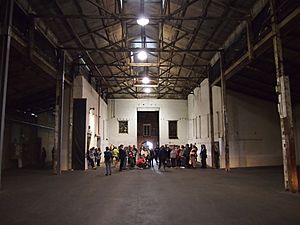Queen's Theatre, Adelaide facts for kids
The Queen's Theatre is a very old and important building in Adelaide, South Australia. It is the oldest theatre still standing on mainland Australia. It was first built way back in 1840. The only theatre in Australia that is even older is the Theatre Royal in Hobart, Tasmania, which opened in 1836. However, the Queen's Theatre wasn't the very first theatre in Adelaide. Two simpler places opened in 1838 and 1839 before it.
The first Queen's Theatre only stayed open for a couple of years. A tough economic time forced it to close, and the building was used for other things. A place called the New Queen's Theatre then opened in a nearby tavern's billiard room from 1846 to 1850. After that, the original Queen's Theatre was fixed up and reopened in 1850 as the Royal Victoria Theatre. People often called it "The Victoria". It was Adelaide's only theatre until 1868. Then, a new theatre, the Theatre Royal, opened on Hindley Street, and the Victoria closed. After being used for many different things, the building was bought by Heritage SA in the 1980s. It was finally restored and opened again for performances in 1996 during the Adelaide Festival.
Contents
History of the Theatre
Early Theatres in Adelaide
In the early 1800s, live shows became very popular in Australia. But there weren't many special places to hold these shows. By the 1830s, both Sydney and Hobart had their first theatres. The very first theatre to open in Adelaide was the Theatre Royal in 1838. It was on the first floor of the Adelaide Tavern on Franklin Street. This was only two years after the colony of South Australia began. Later, in 1839, an actor named Samson Cameron opened the Royal Victoria Theatre. He used a converted warehouse on North Terrace for his shows.
The First Queen's Theatre
People wanted a bigger and better theatre as Adelaide grew. A newspaper, the South Australian Register, announced that Mr. Solomon was building a large and beautiful building. He planned to make it into a theatre.
This theatre was built in 1840 for £3000 by two brothers, Emanuel Solomon and Vaiben Solomon. They were successful businessmen. It could hold over 1000 people. The project faced some doubts from the newspapers. It opened on January 11, 1841, with the play Othello. The manager, John Lazar, played the main role. The reviews were mixed.
Sadly, people stopped going to shows as much because of a financial downturn. This happened after a time of growth under Governor Gawler. After losing money for months, Lazar closed his theatre company. The building was then used for public meetings and talks. In 1843, the government rented the theatre from Solomon. They used it as a court and for government offices for three years.
Between 1846 and 1847, Solomon tried to sell the theatre and a nearby tavern. He tried to do this through a lottery, but it didn't work out. So, he gave people their money back.
Reopening as the Royal Victoria Theatre
The building was reopened as a theatre on December 23, 1850. It was managed by John Lazar and George Coppin. They decided to use the name Royal Victoria Theatre again.
In 1861, the theatre closed for major renovations and changes. It reopened in July with a new manager. The Royal Victoria was Adelaide's only theatre for a while. But then, the new Theatre Royal opened on Hindley Street in 1868. This new competition led to the closure of the "Victoria".
Other Uses of the Building
After closing as a theatre, the building was used for many different things. It became a dance hall called the "Prado". Then, it was the main office for the City Mission. From 1877 to about 1900, it was used as a place to buy and sell horses. From 1908 to 1928, a politician named John Shannon used the building. He had sales yards, stables, and a blacksmith's shop there.
Between 1933 and 1973, different companies used the building as a store or warehouse.
The Queen's Theatre Today
In the 1980s, the building was almost torn down. But then, parts of the original theatre were found inside. This discovery caused many people to protest and demand that the building be saved. Even famous people like Barry Humphries joined in.
Some of the old features found included dressing rooms and the orchestra pit. The South Australian Government bought the building in the 1990s. They worked hard to protect its old architecture. As of 2019, the outer shell of the original theatre is still there. It is inside the 1850s front of the Royal Victoria Theatre.
Digging at the site also found many important historical items. These included old clay pipes, bottles, plates, buttons, and even parts of costumes. The most special find was a gold and ruby earring with ivy leaves. This earring is now part of a collection managed by the History Trust of South Australia. Most of the other items were moved to the South Australian Museum in 2016.
The Queen's Theatre reopened as a performance venue at the 1996 Adelaide Festival of Arts. The first show was The Magic Flute by Opera Australia. After more important repairs, it reopened again for the 1998 Festival. The theatre is still used for performances and events today. However, there are strict rules to help keep the old character of the building safe.
Arts South Australia managed the theatre from 2010 to 2018. After that, GWB McFarlane Theatres took over.
New Queen's Theatre (1846−c.1850)
A different theatre, called the New Queen's Theatre, was built in 1846. It was for George Coppin and was on land near Light Square. The architect Thomas Price designed it. This hall could hold 700 people. It was special because it did not allow smoking in the theatre boxes. In January 1850, a newspaper called the South Australian Register wrote an article about the New Queen's Theatre. The article said the theatre was a place that caused bad behavior. It claimed that no one could watch a show there without feeling upset. The newspaper also said that no lady could enter without being affected. This article led to a court case against the editor, John Stephens, which he lost.
The Adelaide Garrick Club might have been the last group to perform plays there. They put on three comedies in September 1850. After November 1850, there are no more newspaper mentions of this theatre.



